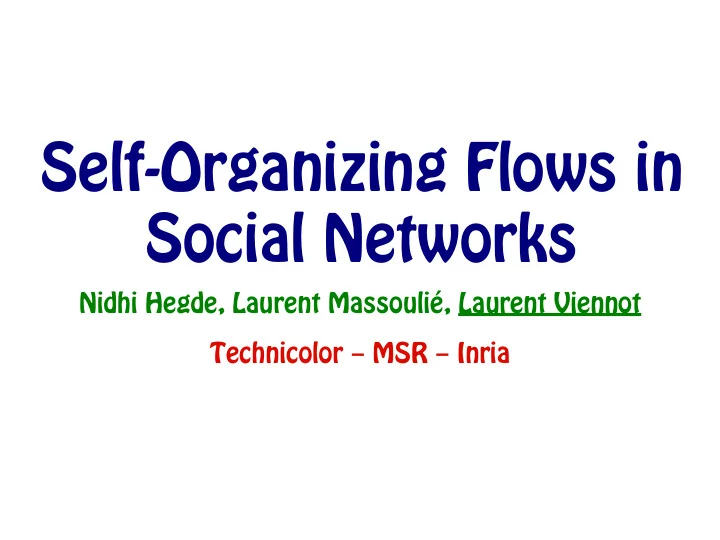

Self-Organizing Flows in Social Networks Nidhi Hegde, Laurent Massoulié, Laurent Viennot Technicolor − MSR − Inria
Network fl ow game • Twitter like game: • To play: change your connections • The goal: gather interesting information • The cost: fi lter out spam 2
Network fl ow game 3
Network fl ow game 4
Network fl ow game 5
Network fl ow game 6
Network fl ow game 7
Network fl ow game 8
Model • Interests : • Each user u has an interest set S_u ⊆ S. • She retransmits news about subjects in S_u. • Links : • User u can create link vu (u « follows » v). • Budget of attention : • User u can follow at most D_u nodes. 9
Problem • Who should I follow ? 10
Problem 11
Problem • Each user u is a player of the following game : • change the users she follows (with deg ≤ D_u) • to maximize U_u=|R(u) ∩ S_u| where R(u) denotes the subjects she receives. • How does this evolves (sel fi sh dynamics) ? 12
Questions to answer • Does this converges ? • If so, what is the price of anarchy : • U*= ∑ U_u under best global choice of links, • over U= ∑ U_u under worse sel fi sh equilibrium. 13
Related work • Convergence of dynamics [Rosenthal ’73, Monderer & Shapley ’96] • Network creation games [Roughgarden ’07, ...] (connectivity, distances, in fl uence, ...) • B-matching and preferences in P2P [Mathieu et al. ’07] • Communities as a coloring game [Kleinberg &Ligett‘10] [Ducoffe, Mazauric, Chaintreau‘13] 14
Outline • Homogeneous interests • Heterogeneous interests • Metric model of interests 15
Homogeneous interests 16
Homogeneous interests • Assume all nodes have same interest set S. • Def : U*is the highest utility a node can get. • Th 1 : If D_u ≥ 3 for all u, then sel fi sh dynamics always converge to a Nash equilibrium where each user receives at least (d-2)/(d-1) U* subjects. • The price of anarchy is thus 1+O(1/d). 17
Proof idea • Stable solution is not too far from optimal 18
Proof idea • D_u ≥ 3 implies strong connectivity • No transitivity arc implies m ≤ 2n • At most 2 links per node for connectivity • d-2 links for gathering subjects instead of d-1 19
Degree 2 (a) Benchmark configuration (b) A Nash equilibrium configuration 20
Proof idea : dynamics • n_i = number of users gathering i subjects • (n_0, n_1, ..., n_p) decreases in lexicographic order p-i • - ∑ n_i n is a potential function. 21
Not a congestion game 2: A 4-cycle ( A, C ) ! ( B, C ) ! ( B, D ) ! ( A, D ) ! ( A, C ) in the strategy space. +1 +1 -1 +2 22
Heterogeneous interests 23
Heterogeneous interests • Th 3 : The price of anarchy can be Ω (n/d). • Prop : Sel fi sh user dynamics may not converge. 24
Price of Anarchy (a) Interest sets (b) Benchmark configuration 25 (c) A Nash equilibrium configuration
Non convergence ! · · · ! Figure 4: Instability with heterogeneous interest sets. User \ Topic a b c d x y k l u 1 2 2 2 0 1 1 ✏ ✏ u 2 2 0 2 2 1 1 ✏ ✏ Table 1: User-specific values for topics. 26
Structured interests 27
Structured interests 28
Structured interests 29
Structured interests • Subjects are in a metric space. • B(s,R) is the ball of subjects at dist. ≤ R from s. • The interest set of each u is a ball B(s_u,R_u). 30
Suf fi cient conditions for optimality • g-doubling : any B(s,R) is ⊆ in ≤ g balls rad. R/2 • r-covering : ∀ s ∈ S, ∃ u dist(s,s_u) ≤ r and R_u ≥ r. • (r,a)-sparsity : ∀ s ∈ S, |B(s,r)| ≤ a • r-interest-radius regularity : ∀ u,v s.t. dist(s_u,s_v)<3R_u/2+r, we have R_v ≥ R_u/2+r 31
Suf fi cient conditions for optimality • Prop : Under the previous assumptions, ∃ G s.t. each u receives all s ∈ S_u and has indegree at most ga+g^2 log R_u/r. • Optimal if ga+g^2 log R_u/r ≤ D_u for all u. 32
Suf fi cient conditions for stability • Expertise- fi ltering rule : when u follows v, it receive only s s.t. dist(v,s) ≤ dist(u,v). • Nearest subject fi rst : when reconnecting, u gives priority to subjects closer to s_u, i.e. reconnected to get s ∉ R(u) iff no subject s’ with dist(s_u,s’) < dist(s_u,s) is lost. 33
Suf fi cient conditions for stability • Th 2 : With expertise fi ltering and nearest- subject- fi rst priority, if the metric satis fi es the previous conditions on the metric, and D_u ≥ ga +g^2 log R_u/r for all u, then sel fi sh dynamics converge to a state where each user receives whole his interest set. • Convergence is fast : logarithmic number of rounds. 34
Summary of results Interests Convergence Price of Anarchy Homogeneous Yes (exp.) Low (deg. ≥ 3) Heterogeneous No High Metric space Yes (log.) Opt. (log. deg.) 35
Conclusion / Perspectives • Simple model with already complex dynamics. • Structured interests with natural rules may explain tractability. • TODO : study the structure of interests through real data. • Better model spam: cost(vu) = |S_v|/|S_v ∩ S_u| 36
Recommend
More recommend